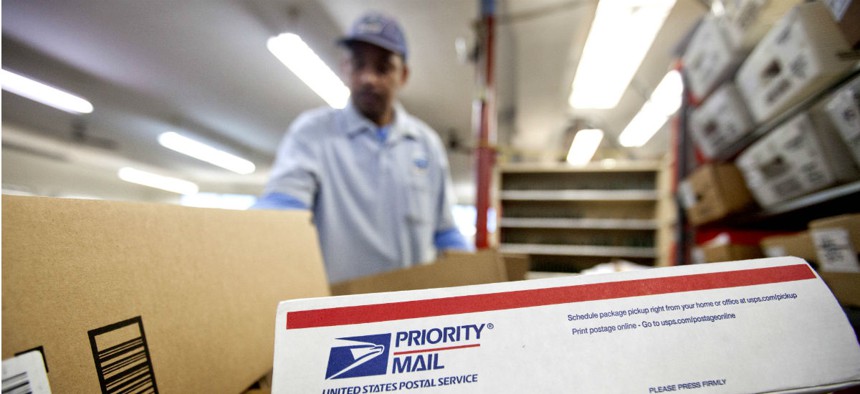
David Goldman/AP file photo
USPS Has Not Saved as Much as It Expected From Cutting Post Office Hours
The Postal Service has used faulty data and isn’t factoring in its revenue losses, auditor says.
The U.S. Postal Service has saved less money than it anticipated from its long-term plan to cut hours at post offices across the country, according to a new report, and it has used incomplete and inaccurate information to make its savings estimates.
USPS neglected to factor in potential revenue losses when suggesting it would save $500 million annually by keeping post offices open two, four or six hours per day instead of eight hours, according to the Government Accountability Office. Even without factoring in the net effects, the Postal Service has lowered its projected savings from half a billion per year to $337 million annually due to increased labor costs, a 35 percent reduction.
The GAO report found USPS saved just $306 million from fiscal year 2012 through June 2015 on its Post Office Structure (POSt) Plan. The Postal Service began cutting hours at more than 13,000 post offices as a compromise after the agency initially threatened to close certain locations entirely. As part of the plan, USPS also intended to separate many of the postmasters and other career employees staffing the post offices and replace them with part-time or non-career workers, who earn less in salary and benefits.
Postal Service management conceded its POStPlan savings estimates, which were presented to the Postal Regulatory Commission to justify the cuts, were “quick and dirty” and lacked sophistication. GAO called the assessments “unreliable.”
“Although POStPlan was an initiative that affected about 66 percent of USPS’s post offices and postmasters,” the auditors said, “USPS did not produce cost savings estimates with the level of rigor that an initiative with such a large footprint may have warranted.”
USPS used “imprecise and inaccurate” labor costs in its estimates, mired with errors in the data and using averages that ignored large disparities at individual locations. The agency also neglected to prepare a “sensitivity review,” which would have presented a range of possible outcomes in savings based on potential changes in underlying assumptions. The primary cause for USPS adjusting its estimate stemmed from an arbitrator’s mandate that the agency use career or union-backed employees to staff many positions at the post offices with reduced hours. GAO said if the Postal Service had baked some contingencies into its estimates -- the mailing agency said it was aware the arbitration ruling was a possibility -- it could have better prepared for that outcome.
GAO also said the Postal Service ignored longstanding guidance from the Office of Management and Budget that federal agencies factor net outcomes when calculating potential savings. By not considering potential lost revenue at post offices staying open less, USPS failed to meet that directive, the auditors said. USPS has said revenue was down 4 percent at post offices since the POStPlan went into effect, but GAO found it was actually down 10 percent specifically at the facilities that cut hours. Without further analysis, GAO said the Postal Service would not be able to determine to what extent that lost revenue has resulted from the reduction in hours.
As the Postal Service undertakes a slew of efforts to cut costs and right size its operations, GAO said, the agency should prioritize accurate information to better inform its decision making.
“Without reliable data and quality methods for calculating the potential savings USPS expects to achieve through its initiatives,” GAO wrote in its report, “the actual savings they achieve, and the effects on revenue, USPS officials and oversight bodies may lack accurate and relevant information with which to make informed decisions regarding future cost-saving efforts in a time of constrained resources.”
The National Association of Postmasters of the United States said in a statement the report validates a previous call the group made for a moratorium on the POStPlan. A comprehensive postal reform bill introduced by Sen. Tom Carper, D-Del., would institute such a pause.
The Postal Service, however, rejected the “tone” of the GAO report. The agency said the bottom line remains the agency made the right decision because it saved money, and called the decision to cut hours a “reasonable” one. GAO said it was not commenting on the “reasonableness” of the policy -- and acknowledged the POStPlan “most likely resulted in some savings” -- but instead that USPS should be making decisions based on more accurate and complete data.
NEXT STORY: How Trump Rose to the Top of the GOP Race







